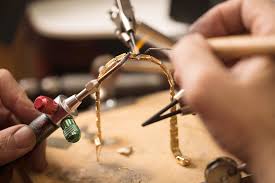
When to Repair vs. Replace: A Guide for Your Beloved Items
Share
When to Repair vs. Replace: A Guide for Your Beloved Items
From heirloom jewelry to everyday accessories, our cherished possessions often hold both monetary and sentimental value. But when something breaks, wears out, or loses its luster, how do you decide whether to repair it or replace it? This guide will help you make the best choice for your treasured items.
1. Signs Your Item Needs Attention
Before deciding, assess the condition of your piece:
Jewelry & Watches
-
Loose or Missing Stones: Prongs can wear down over time, risking gemstone loss.

-
Broken Clasps or Chains: A snapped chain or faulty clasp may be a simple fix.
-
Tarnished or Discolored Metal: Silver and gold can often be restored with professional polishing.
-
Scratched or Dull Surfaces: Buffing can revive many metals and gemstones.
Household Items (Clocks, Leather Goods, etc.)
-
Stopped or Inaccurate Movements (Watches/Clocks): May just need cleaning or minor adjustments.
-
Cracked Leather or Broken Stitching: Can often be repaired if the material isn’t too deteriorated.
-
Loose Hinges or Fasteners: Many bags, belts, and small goods can be reinforced.
2. When to Repair
Repairing is often the best choice when:
Sentimental Value Outweighs Cost
-
Family heirlooms, wedding bands, or gifts with emotional significance are worth restoring.
-
A simple repair (like resizing a ring or replacing a watch battery) can extend its life for years.
The Damage is Minor
-
Broken chains, missing stones, or tarnished metal can often be fixed affordably.
-
Watches that stop working may just need cleaning rather than replacement.
High-Quality Materials
-
Solid gold, platinum, or genuine gemstone pieces are usually worth repairing.
-
Well-made leather goods or vintage items can often be revived with professional care.
3. When to Replace
Sometimes, replacement is the more practical option:
The Cost of Repair Exceeds the Item’s Value
-
If repairing a piece costs more than buying a new one (e.g., a cheap fashion necklace with a broken clasp).
-
Mass-produced items with little intrinsic value may not be worth fixing.
Irreversible Damage
-
Cracked or shattered gemstones (unless they hold sentimental value).
-
Severely corroded or eroded metal that can’t be restored.
-
Electronics in vintage watches if parts are no longer available.
Changing Tastes or Needs
-
If you no longer wear or use the item, repurposing (e.g., turning a pendant into a ring) may be better than repair.
-
Outdated designs might not be worth restoring if you prefer a modern look.
4. Cost Comparison: Repair vs. Replace
| Scenario | Repair | Replace |
|---|---|---|
| Loose gemstone in an engagement ring | ✅ (Affordable tightening) | ❌ (Sentimental loss) |
| Broken clasp on a cheap bracelet | ❌ (May cost more than the bracelet) | ✅ (Inexpensive to replace) |
| Tarnished silver necklace | ✅ (Polishing is cost-effective) | ❌ (Wasteful if fixable) |
| Vintage watch with a broken movement | ⚠️ (Depends on parts availability) | ✅ (If repair is too costly) |
5. Eco-Friendly & Emotional Considerations
-
Sustainability: Repairing reduces waste and preserves resources.
-
Sentimental Attachment: Some items carry memories that can’t be replaced.
-
Upcycling Ideas: Turn broken jewelry into new pieces (e.g., earrings from a damaged necklace).
6. How to Find a Trusted Professional
-
Jewelers & Watchmakers: Look for specialists with good reviews and certifications.
-
Leather & Bag Repair: Cobblers or dedicated repair shops often handle accessories.
-
Ask for Estimates First: Compare repair costs vs. replacement before deciding.
